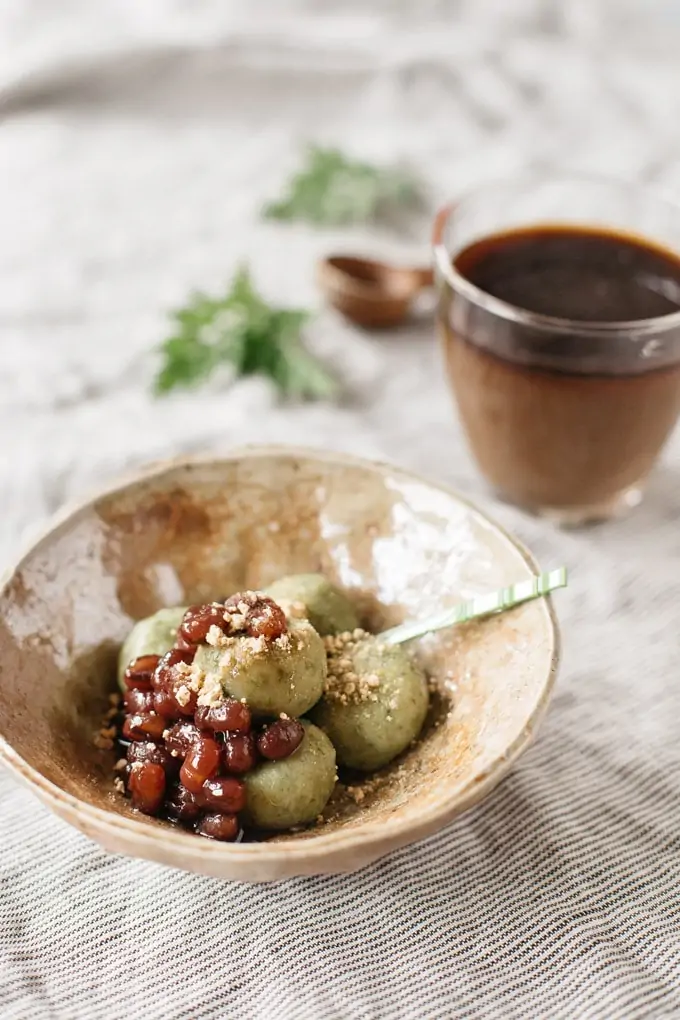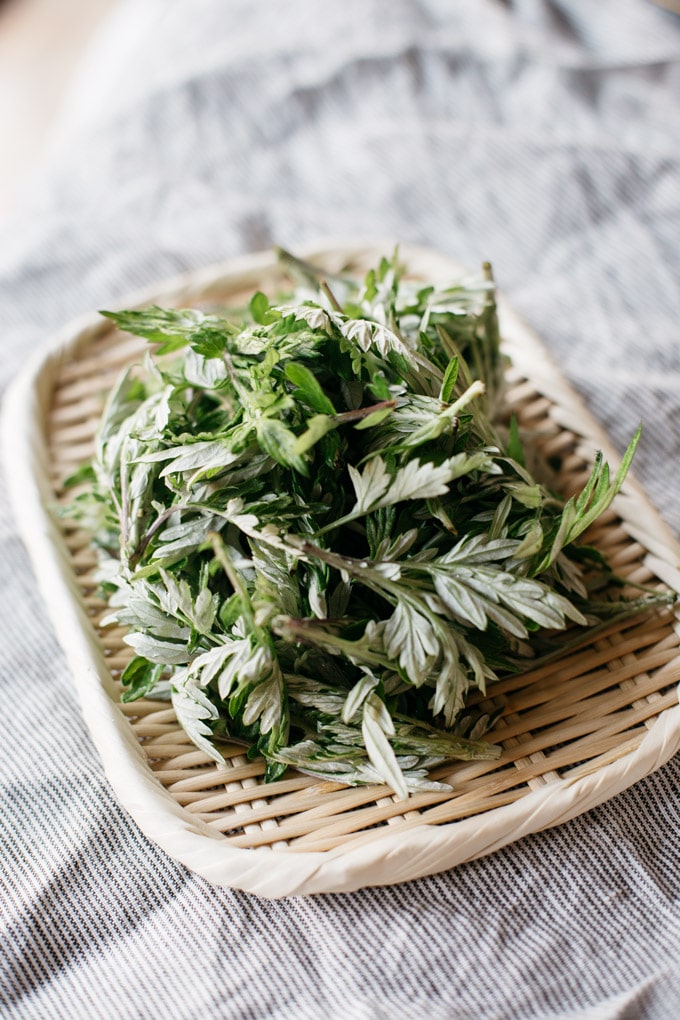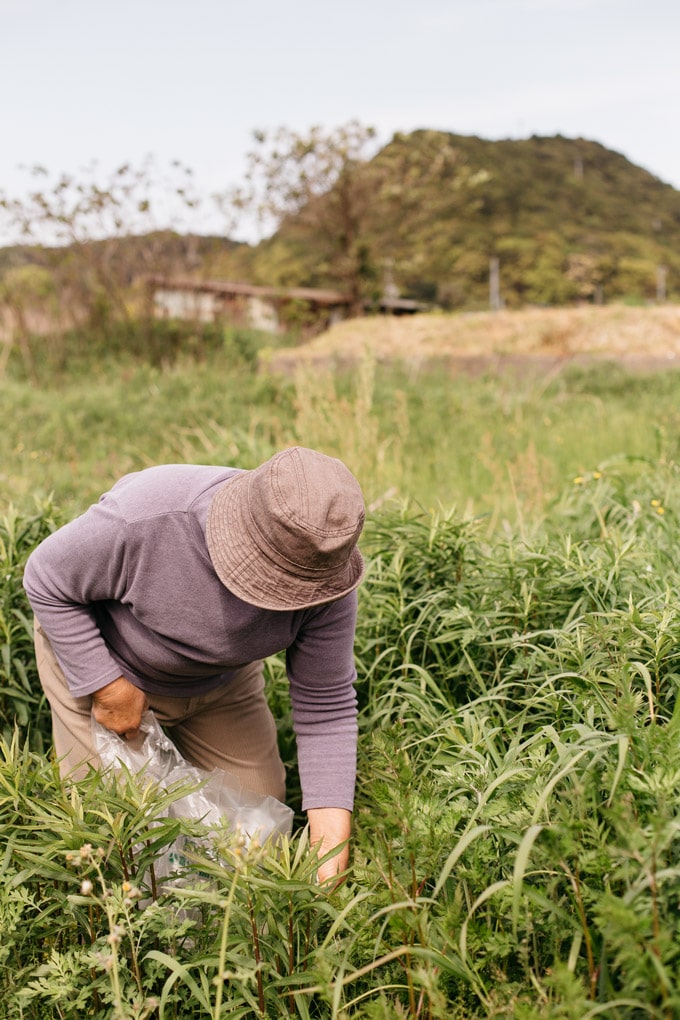Yomogi, like matcha, is an ingredient added to bring a green colour to sweets in Japan to please the eye and add a tasty flavour. I got to hand-pick some yomogi while I was in Japan and create Yomogi Dango with anko and kinako to make a sweet snack.
What is Yomogi?
Yomogi is Japanese mugwort which is usually used for making “Yomogi dango” and “Kusa mochi” because of its natural aroma and beautiful green colour. Japanese mugwort was also in season when we went back to Japan to see Sakura Cherry blossom flower. It is perennial plant but its season “Shun” is from March to May. Only fresh and new soft sprout is used for cooking. So when we went back we found a lot of them near by my mother’s veggie patch.
I actually love Japanese mugwort and have bought mugwort in a pot in Brisbane for A$12 (!!) because I wanted to make Yomogi dango in Brisbane but it died…We picked about 1kg of soft new wild sprout in my home town in Japan. That brings back my child hood memory of picking mugwort for making mochi for new years at the end of every year with my grandmother because we always made two colours of mochi, one was plain white and another was coloured green with Japanese mugworts.
How to cook Yomogi?
Only pick about 10 cm from the end of new and soft sprouts because the old ones are quite stiff and strong in astringent taste. After mugworts’ new sprouts are picked, wash them and blanch them. Usually about 1tsp of bicarbonate soda is added to the blanching water in order to remove the strong astringent taste if using old leaves, but if the leaves are new sprouts and soft, adding bicarbonate soda is unnecessary.
Soak the blanched yomogi leaves in a bowl of cold water then drain and squeeze out the excess moisture. Then use a food processor to grind the leaves. In the photos below, at my mother’s house she only had a super old mixer so we did not squeeze out much water because otherwise the motor would have been burnt.
Where to buy and how to store Yomogi?
It will be great if you can find Japanese mugwort in the natural environment but if you can’t, there is Dried Japanese mugworts and you can purchase them from Japanese grocery stores or online. It will keep for a few days in the fridge and a month in the freezer. If you are lucky enough to pick them from the natural environment, after you create the paste following the above preparation steps, freeze them in ice cube trays so that it will be handy mini size frozen yomogi paste.
We made Yomogi Dango, served with sweet azuki bean paste “anko” and soy bean powder “Kinako“. It was delicious and full of yomogi flavour!
If you liked my recipe for Yomigi Dango, please rate it and leave a comment below. Also, don’t forget to follow me on Youtube, Pinterest, Facebook , Twitter and Instagram to keep up to date with all the latest happenings on Chopstick Chronicles. Don’t forget to use the hashtag #ChopstickChronicles so I can see your wonderful creations!

Yomogi Dango
Ingredients
Yomogi paste
- 1 kg yomogi freshly picked
- 1 tsp bicarbonate soda *1
- 2 litre water for blanch
Yomogi Dango
- 200 g Shiratamako(rice flour)
- 200 g Silken tofu
- 2 tbs yomogi paste
- 2 tbs sugar
- 4 tbs sweet azuki bean paste *2
- 4 tsp Kinako soy bean powder *3
Instructions
Yomogi paste
- Wash yomogi throughly under running water, drain excess water, and set aside
- Boil water in a large stock pot over high heat
- Add bicarbonate soda to the pot.
- Add yomogi to the pot and blanch them for a minute.
- Take yomogi out into a strainer to drain the boiling water.
- Soak the drained yomogi in cold water in a bowl for 10 to 15 minutes.
- Drain the water using strainer.
- Make paste of yomogi in a food processor.
Yomogi Dango
- Place flour, tofu, and yomogi paste in a large mixing bowl.
- Combine and knead the ingredients all together with your hand.
- The dough should be the same softness as your earlobe.
- Divide the dough in half.
- Roll the divided dough into a long cylinder shape (2cm in diameter). Chop them into 16 equal sized pieces.
- Round each piece with two hands and repeat same with the other dough.
- Boil water in a large pot over high heat.
- Add the dango all together.
- Dango will float on the surface of the boiling water when it is cooked.
- Scoop the floating dango into a bowl of cold water.
- Drain the cold water and serve the cooked dango in a small serving bowl with azuki bean paste and sprinkle kinako soy bean powder.







I must have missed something or blind. There is “2 tbs sugar” listed in the yomogi section of the recipe. Is that for mixing with the kinako flour topping or with the shiratamako in the dough section?
Hi Joe, it is going into the yomogi dango dough.
Hope mom finally got a food processor! ☺☺☺
😀 I don’t think she never will:D
Hi, I bought yomogi powder from Tomiz. Will it require blanching and soaking too?
Hi Belle, I often use Tomiz too. Well, if it is in powder form, you do not need blanching and soaking. I have never used powder one so I am not sure how much but you need to adjust flour amount, depends on how much powder you add.
Hello, I live in Australia too and first tried kusa dango when I visited Japan. I’ve tried so hard to find it everywhere but with no luck 🙁
Would you know of any places in Australia that would sell it?
Hi Enna 😀 Which part of Australia do you live? I live in Brisbane and found Yomogi at a local nursery and growing it myself because I have not found any shop selling them. So I can only make a tiny bit. Unlike Japan, Yomogi is not growing everywhere even like roadside and they are all FREE. I bought Yomogi in a little pot and planted in my backyard. I grow Shiso, Mitsuba and yomogi those hard to find but they are common in Japan.Try specialty nursery who have rare herbs? I will keep my eye out and if I find like dried one, or in powder form in Australia or online, I will let you know 😀
In England the yomogi which we call mugwort is less aromatic, so I harvest the flowering tops instead. I may try using them to make this recipe!
Hi Miles, yes it is called mugwort too. I am trying to grow here in Australia too. It is not growing everywhere like it is in Japan… Hope you your flowering tops turn out delicious dango 😀
This certainly looks like a delicious dish and your photos are absolutely stunning!
Thank you Stephanie 😀
My husband lived in Japan for two years and I’m so excited to surprise him with this dish! He will LOVE it.
Hi Nellie, he will love it and bring back his memory of Japan and Japanese taste 😀